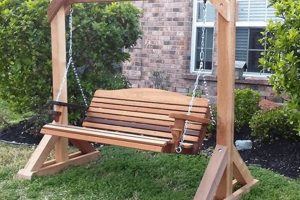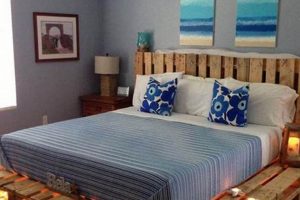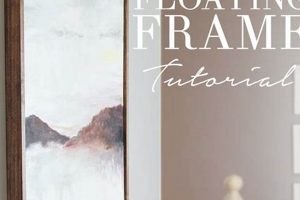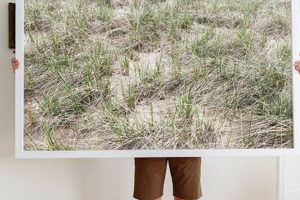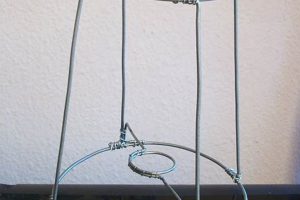Structures designed to protect plants from harsh weather conditions, typically constructed from readily available materials, offer a controlled environment for extending the growing season. These simple enclosures, often built with wood, plastic, or repurposed windows, trap solar radiation, raising the internal temperature and shielding plants from frost, wind, and excessive precipitation. For example, a basic frame made from scrap lumber and covered with a sheet of polycarbonate provides a sheltered space for seedlings or overwintering plants.
The implementation of such protective measures holds significant value for gardeners and farmers seeking to enhance crop yields and prolong the harvest. The controlled environment fosters earlier germination, promotes faster growth, and safeguards delicate plants from damaging elements. Historically, these structures have been employed to cultivate crops in regions with shorter growing seasons, enabling the production of fresh produce throughout the year. This approach reduces reliance on imported goods and contributes to greater food security.
Understanding the principles of thermal regulation and material selection is paramount to successful design. Optimal orientation, ventilation techniques, and the choice of appropriate covering materials are critical factors that influence the effectiveness of these constructions. Subsequent sections will delve into specific design considerations, material options, and construction techniques for creating effective and durable plant protection systems.
Design and Construction Considerations
Effective construction requires careful planning and execution. The following guidelines outline best practices for ensuring optimal performance and longevity.
Tip 1: Site Selection is Crucial: Prioritize a location that receives ample sunlight, particularly during the winter months. Southern exposure is generally preferred to maximize solar gain. Consider proximity to a water source and protection from prevailing winds.
Tip 2: Frame Construction Materials Impact Performance: Lumber, concrete blocks, and straw bales are common choices. Lumber provides a stable and easily customizable frame. Concrete blocks offer durability and thermal mass. Straw bales provide excellent insulation. Choose materials appropriate for the climate and desired lifespan.
Tip 3: Glazing Material Selection Affects Light Transmission: Options include glass, polycarbonate, and polyethylene film. Glass offers excellent light transmission but is fragile. Polycarbonate is durable and provides good insulation. Polyethylene film is an economical choice for temporary structures but offers limited durability.
Tip 4: Ventilation is Essential for Temperature Regulation: Implement vents or hinged lids to prevent overheating on sunny days. Proper ventilation reduces humidity and minimizes the risk of disease. Consider automated ventilation systems for precise temperature control.
Tip 5: Orientation and Angle Influence Solar Gain: Orient the structure with the glazing facing south to maximize solar energy absorption. Adjust the angle of the glazing to optimize light penetration during different seasons.
Tip 6: Consider Integrating Thermal Mass: Incorporate materials such as water jugs or dark-colored rocks to absorb and store heat during the day, releasing it at night. This helps to moderate temperature fluctuations.
Tip 7: Design for Accessibility: Ensure easy access for planting, watering, and harvesting. Consider the height and width of the structure to accommodate plant growth and human movement.
Attention to these details will result in a functional structure that effectively extends the growing season and protects plants from environmental stressors.
The subsequent sections will explore specific construction techniques and maintenance strategies to ensure the sustained performance of the structure.
1. Sunlight
Sunlight serves as the primary energy source within a cold frame, driving photosynthesis and regulating internal temperatures. The design and orientation directly influence the amount of solar radiation captured. Inadequate sunlight exposure results in stunted plant growth, reduced yields, and increased susceptibility to diseases. For instance, positioning the structure behind a tall building that casts a shadow for a significant portion of the day negates the benefits of environmental protection. The selection of glazing materials also plays a critical role; clear polycarbonate transmits more light than opaque or heavily tinted materials, thereby optimizing photosynthetic activity.
The angle of the glazing relative to the sun’s path affects the amount of light penetrating the structure. In winter, when the sun is lower in the sky, angling the glazing surface perpendicularly to the sun’s rays maximizes solar energy capture. This strategy is crucial for maintaining optimal temperatures and promoting plant growth during the colder months. Furthermore, the internal surfaces of the cold frame can be painted white or covered with reflective material to redistribute sunlight more evenly, ensuring that all plants receive adequate illumination, even those located in shaded areas.
Therefore, understanding the principles of solar radiation and its interaction with materials is paramount to effective design. The selection of a suitable location, optimization of glazing angles, and utilization of reflective surfaces are essential considerations. A poorly positioned or inadequately designed structure undermines the intended benefits, potentially leading to plant failure and negating the value of the endeavor. Maximizing light is vital.
2. Insulation
Insulation is a critical component in the effective operation of plant protection structures. Its primary function is to minimize heat loss from within the enclosure, thereby maintaining a more stable and favorable temperature for plant growth, particularly during periods of low ambient temperatures. The effectiveness of insulation directly influences the internal temperature and, consequently, the viability of plants housed within the structure. The impact of inadequate insulation manifests in the form of frost damage, stunted growth, and even plant death. For example, a simple frame covered only with a single layer of polyethylene film provides minimal insulation, rendering it ineffective against severe frost conditions; the internal temperature rapidly equilibrates with the external environment, offering little protection to sensitive plants.
The selection of appropriate insulating materials and construction techniques is paramount. Materials with high thermal resistance, such as straw bales, rigid foam insulation boards, or multiple layers of glazing, significantly reduce heat transfer. Straw bale construction, for instance, offers excellent insulation due to the air pockets trapped within the bales. Similarly, double-layered glazing creates an insulating air gap that minimizes conductive heat loss. In practice, combining a well-insulated frame with strategic placement and ventilation can significantly extend the growing season. Consideration of thermal mass, achieved by incorporating water-filled containers or dark-colored stones within the structure, can further stabilize temperature fluctuations by absorbing heat during the day and releasing it at night.
In summary, insulation is not merely an optional feature but an essential element in the design and construction of effective plant protection structures. The choice of materials and construction methods directly impacts the internal temperature, influencing plant health and productivity. Challenges arise in balancing insulation with ventilation requirements and cost considerations. A thorough understanding of thermal dynamics and the properties of insulating materials is crucial for optimizing the effectiveness of these structures and maximizing the benefits of extended growing seasons. Therefore, insulation must be a factor.
3. Ventilation
Ventilation constitutes a critical regulatory mechanism within a cold frame environment. While these structures excel at trapping solar radiation and insulating plants from external temperature extremes, the controlled environment can rapidly become detrimental without adequate air exchange. Excessive heat buildup, coupled with elevated humidity levels, fosters conditions conducive to disease proliferation and inhibits optimal plant growth.
- Temperature Regulation
The primary role of ventilation is to prevent overheating. On sunny days, even during cold weather, internal temperatures can quickly escalate to levels detrimental to plant health. Vents strategically positioned within the structure allow for the release of excess heat, maintaining a temperature range conducive to plant growth. Without ventilation, temperatures may exceed the tolerance levels of the plants within. Passive ventilation strategies, such as manually opening and closing vents, are common in basic designs. More sophisticated systems may incorporate thermostatically controlled vents that automatically adjust based on internal temperature sensors.
- Humidity Control
Elevated humidity levels promote fungal diseases and hinder transpiration, the process by which plants regulate their internal water balance. Ventilation facilitates the removal of moist air, reducing the risk of disease outbreaks and improving air circulation around the plants. Adequate ventilation reduces the likelihood of fungal pathogens establishing themselves. Simple vents, strategically placed to encourage cross-ventilation, can significantly reduce humidity levels. Larger structures may require fans to ensure adequate air circulation throughout the entire space.
- Gas Exchange
Plants require carbon dioxide for photosynthesis and release oxygen as a byproduct. In a sealed environment, carbon dioxide levels can become depleted, limiting photosynthetic activity. Ventilation facilitates the exchange of gases, replenishing carbon dioxide levels and removing excess oxygen. Proper ventilation ensures plants have an adequate supply of carbon dioxide. A poorly ventilated structure will not grow as well. Even small amounts of air exchange can significantly impact plant growth.
- Structural Integrity
While not a primary function, ventilation also contributes to structural integrity by mitigating condensation buildup. Condensation can lead to material degradation, particularly in wooden structures. Adequate airflow reduces the amount of moisture accumulating on the interior surfaces, prolonging the lifespan of the structure. Furthermore, constant condensation can create a breeding ground for mold and mildew, compromising air quality within the structure.
The integration of effective ventilation strategies is paramount to the successful operation of these structures. A failure to adequately address ventilation needs results in an environment that, while initially protective, ultimately undermines plant health and productivity. Balancing the benefits of insulation with the necessity of air exchange is crucial for optimizing the growing environment. Ventilation improves growth and airflow.
4. Materials
The selection of appropriate materials directly determines the functionality, durability, and cost-effectiveness of a cold frame. The relationship is causal: material properties dictate the structure’s ability to insulate, transmit light, and withstand environmental stresses. For instance, using untreated lumber for the frame, a cost-saving measure initially, leads to premature rot and structural failure, necessitating costly repairs or complete replacement. Conversely, employing rot-resistant cedar or pressure-treated lumber extends the lifespan and reduces maintenance demands. The choice between glass and polycarbonate for glazing exemplifies the trade-offs involved. Glass offers superior light transmission but is susceptible to breakage, while polycarbonate provides impact resistance and better insulation, albeit at a higher cost and with slightly reduced light penetration. The effectiveness of a cold frame in protecting plants is fundamentally linked to the material properties of its components.
Practical applications illustrate the significance of material selection. A cold frame constructed with salvaged windows and a frame of reclaimed lumber represents a cost-effective and environmentally sustainable approach. However, the uneven dimensions of salvaged materials require careful planning and construction to ensure structural integrity and efficient light capture. Conversely, a cold frame built with new, standardized materials, such as polycarbonate panels and a metal frame, offers ease of assembly and consistent performance but at a greater initial expense. Straw bales offer high insulation. The integration of thermal mass, such as dark-colored rocks or water-filled containers, further enhances temperature regulation, but requires careful consideration of weight distribution and structural support. Each material choice presents unique challenges and opportunities that influence the overall performance and longevity of the structure.
In summary, the successful construction hinges on informed material selection. Understanding the properties of various materials, their relative costs, and their suitability for the intended purpose is crucial. While cost is a factor, prioritizing durability and insulation ensures long-term effectiveness and reduces maintenance requirements. The appropriate material choices are fundamental, a good choice is paramount to the longevity of the cold frame. Overlooking this aspect undermines the benefits of the cold frame and negates the resources invested in its construction.
5. Durability
The longevity and resilience of a cold frame, termed its durability, represent a fundamental consideration in its design and construction. A durable cold frame provides sustained protection to plants over multiple seasons, maximizing the return on investment of time and resources.
- Material Selection and Resistance to Degradation
The materials used in construction directly influence resistance to weathering, rot, and physical damage. Untreated wood deteriorates rapidly when exposed to moisture and soil, whereas materials like pressure-treated lumber, recycled plastic, or metal offer enhanced resistance to decay and insect infestation. Furthermore, the glazing material should withstand impacts from hail, windborne debris, and UV radiation. The selection of appropriate materials is paramount in ensuring a long lifespan.
- Structural Integrity and Load-Bearing Capacity
The structural design must account for anticipated loads, including snow accumulation, wind pressure, and the weight of the glazing material. A poorly designed frame can buckle or collapse under stress, rendering it unusable. Proper bracing, joint construction, and foundation support are essential for maintaining structural integrity. Furthermore, the frame should resist deformation over time, ensuring the glazing remains securely in place.
- Resistance to Environmental Factors and Climate
The cold frame should withstand prevailing climatic conditions, including extreme temperatures, high winds, and heavy precipitation. In regions with severe winters, the structure must be able to bear the weight of accumulated snow without collapsing. Similarly, in areas prone to high winds, the frame must be securely anchored to prevent displacement or damage. The design should also consider the effects of UV radiation on the glazing material, selecting options that resist yellowing and embrittlement.
- Maintainability and Ease of Repair
Even with robust construction, periodic maintenance is necessary to prolong the lifespan of a cold frame. The design should facilitate easy access for cleaning, painting, and replacing damaged components. Modular construction allows for the replacement of individual sections without dismantling the entire structure. Furthermore, readily available replacement parts reduce the time and cost associated with repairs.
The durability of a cold frame is not merely a matter of material strength but a holistic consideration encompassing material selection, structural design, resistance to environmental factors, and ease of maintenance. A well-designed and constructed cold frame provides years of reliable service, protecting plants and extending the growing season. Prioritizing durability ensures a sustainable and cost-effective investment.
6. Accessibility
The concept of accessibility, in the context of DIY cold frames, pertains to the ease with which individuals can interact with and maintain the structure, irrespective of their physical capabilities or constraints. Consideration of accessibility ensures inclusivity, allowing a broader range of individuals to engage in gardening activities and benefit from the extended growing season that cold frames provide.
- Height and Reach
The height of the cold frame structure and the required reach for planting, weeding, and harvesting directly impact accessibility. A cold frame that is too low may require excessive bending or kneeling, posing difficulties for individuals with mobility limitations or back problems. Conversely, a structure that is too high may necessitate reaching overhead, which can be challenging for individuals with limited arm strength or range of motion. Design considerations should prioritize a comfortable working height, potentially incorporating raised beds within the cold frame to minimize bending and stretching.
- Pathways and Maneuvering Space
Sufficient space around the cold frame is essential for individuals using mobility aids, such as wheelchairs or walkers. Narrow or obstructed pathways hinder access and restrict movement, limiting the ability to perform necessary tasks. The surrounding area should provide a clear and level surface, free from obstacles that could pose a tripping hazard. Furthermore, the design should consider the turning radius of mobility devices, ensuring adequate maneuvering space for navigating around the structure.
- Doorways and Openings
The design of doorways and openings should accommodate individuals with varying levels of dexterity and strength. Heavy or cumbersome lids and doors can be difficult to operate, particularly for individuals with arthritis or limited hand strength. Lightweight materials and simple opening mechanisms, such as hinges with adjustable tension, can improve ease of use. Furthermore, the width of doorways should accommodate wheelchairs and other mobility devices, ensuring unobstructed access to the interior of the cold frame.
- Adaptive Tools and Techniques
The incorporation of adaptive tools and techniques can further enhance accessibility for individuals with specific needs. Long-handled tools reduce the need for bending and reaching, while ergonomic grips provide added comfort and control. Raised beds and container gardening elevate plants to a more accessible level, minimizing the strain on joints and muscles. Furthermore, assistive technologies, such as automatic watering systems, can reduce the physical demands of gardening tasks.
Ultimately, prioritizing accessibility in DIY cold frame design extends the benefits of gardening to a wider audience. By carefully considering the physical needs and limitations of potential users, builders can create structures that are both functional and inclusive, fostering a sense of independence and empowerment. The principles of universal design should be applied to create a gardening environment that is welcoming and accommodating for all.
Frequently Asked Questions
The following addresses common inquiries regarding the construction and utilization of plant protection structures.
Question 1: What is the optimal orientation to maximize sunlight exposure?
Southern exposure is generally preferred, particularly in the Northern Hemisphere, as it maximizes solar gain during the winter months. Adjustments may be necessary based on local conditions and the presence of obstructions.
Question 2: Which materials offer the best insulation for cold climates?
Straw bales, rigid foam insulation, and double-layered glazing provide superior insulation. The selection depends on budget, availability, and desired lifespan.
Question 3: How can adequate ventilation be ensured to prevent overheating?
Hinged lids, adjustable vents, and thermostatically controlled systems facilitate air exchange and temperature regulation. Proper placement of vents is crucial for effective cross-ventilation.
Question 4: What measures can be taken to enhance structural durability?
Using rot-resistant lumber, proper joint construction, and adequate bracing enhance structural integrity. Regular maintenance and prompt repairs extend the lifespan.
Question 5: How does the choice of glazing material impact plant growth?
Glass offers excellent light transmission, but polycarbonate provides better insulation and impact resistance. Polyethylene film is an economical option for temporary structures.
Question 6: How to adapt cold frames to varying physical capabilities?
Raised beds, accessible pathways, and adaptive tools enhance usability for individuals with mobility limitations. Consideration of height and reach is essential.
Successful implementation hinges on addressing key considerations. Careful planning and informed decision-making ensure optimal performance and longevity.
Subsequent sections will delve into advanced techniques for optimizing the growing environment and maximizing crop yields.
DIY Cold Frames
This exploration of DIY cold frames has illuminated key considerations for successful implementation. From optimizing sunlight exposure and selecting appropriate materials to ensuring adequate ventilation and prioritizing durability, each aspect contributes to the overall effectiveness of these structures in extending the growing season. A comprehensive understanding of these principles enables informed decision-making during the design and construction phases, fostering a controlled environment conducive to plant health and productivity.
The knowledge presented serves as a foundation for realizing the full potential of DIY cold frames. The application of this information empowers cultivators to enhance crop yields, protect plants from environmental stressors, and cultivate a more sustainable approach to gardening. The ongoing pursuit of innovation and refinement will further optimize the benefits derived from these structures, contributing to increased food security and a deeper connection with the natural world.


